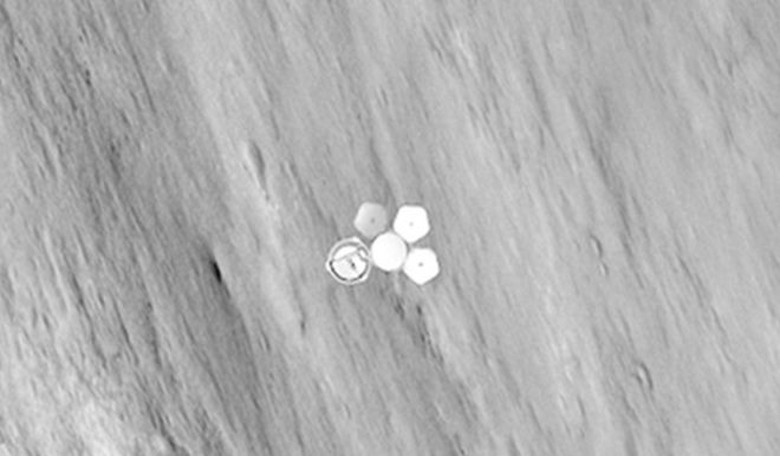New research has shown the UK’s Beagle 2 probe did not crash land on Mars and could even be still gathering information almost 13 years later. British-built Beagle 2 was deployed to the surface of Mars on Christmas Day 2003 from the European Space Agency’s Mars Express spacecraft.
A parachute was meant to slow its descent and airbags should have protected it as it touched down - when no signal was received the team assumed it had crashed but two years ago it was spotted on the Martian surface.
Now a technique called reflection analysis has shown the lander deployed at least three and possibly all four of its solar panels after touching down on the red planet.
Researchers from the UK’s De Montfort and Leicester universities combined 3D software with reflection analysis to match both simulated and real images of Beagle 2 to establish how sunlight would have reflected off the panels.
The results were then compared with original images taken by the HiRISE camera on board the Mars Reconnaissance Orbiter spacecraft.
According to lead digital design researcher Nick Higgett of De Montfort University, the techniques were as close to a definitive explanation as would be possible without landing on the planet itself.
“We are delighted to say that we have gone way beyond the original plan to reach this exciting conclusion that Beagle 2 did not crash but landed and probably deployed most of its panels,” he said.
The analysis also suggests that the probe may even have worked for several months without being able to send its data back to Earth.
Prof Mark Sims, of Leicester University, said the concept was “unique” and had produced “exciting results” indicating after all that the landing went to plan and at least three of its four solar panels opened successfully.
"It may have worked for hundreds of days depending on how much dust was deposited on the solar panels and whether any dust devils were cleaning the panels - as happened with Nasa's Mars Exploration Rovers," he said.
"One possibility is that it could still be working today - but it is extremely unlikely and I doubt that it is."
The Beagle 2 mission was led by the late Prof Colin Pillinger. His spacecraft - named after the Snoopy cartoon character - was capable of collecting soil samples and analysing them for signs of organic molecules associated with life in a miniaturised on-board laboratory.
In 2014, Nasa's Mars Reconnaissance Orbiter (MRO) found Beagle 2 on the Martian surface. The spacecraft took pictures which seemed to indicate that the spacecraft landed as planned and some of its solar panels had opened.
Prof Sims, who worked on Beagle 2, says that he and others who worked on the mission take satisfaction from the fact that the system did seem to work so well.
"We got so close," he said. "We succeeded in so many elements. It is a great pity the communications didn't work and we didn't get the science back. It shows that the Beagle 2 team did an amazing job. It shows that the design was sound. It got there. It landed on Mars at the first attempt."











